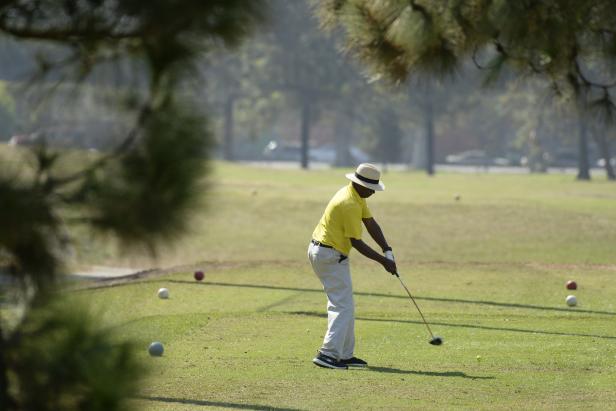Products You May Like
Monte Scheinblum knows firsthand what happens to big hitters as they age. A former long-drive champ, he watched in slow-motion horror as his clubhead speed shrank from 130 miles per hour into the 110s during a two-year period. “Getting old hurts a strong player more,” says Scheinblum, 53, who teaches his power techniques at RebellionGolf.com. “My lesson book is filled with players who used to hit it 280 and play to a 1-handicap and now hit it 210 and want to quit.”
It doesn’t have to come to that. Scheinblum has his clubhead speed back up to 130 mph and can still smash it 330 yards when he chooses. Last year he made it through qualifying and into the U.S. Senior Open.
Whether you’re a long-drive champ or just someone wanting to find 10 more yards, the answer is the same: “It feels powerful to make this aggressive body move at the ball, but it’s wasted motion,” he says. “You have to learn how to do the opposite—which is move the center of mass of the club away from the target at the start of the downswing.”
What does that look like? “All I want you to do is get your lead wrist in some amount of flex in transition,” Scheinblum says. By that he means bowing the wrist joint outward, like you’re showing somebody your wristwatch instead of letting your wrist bend like a V. “It doesn’t matter how much as long as it’s moving in that direction. It’ll take time to assimilate, but just go practice it at two-thirds speed with your 7-iron. You’ll be amazed at what happens when you finally get the mechanical advantage of the club working for you.”
It’s natural to assume the path to more yards has to travel through the gym. Working out has its benefits, but muscle power has little to do with hitting the ball farther, says Golf Digest Best Young Teacher Liam Mucklow, an athletic-movement specialist who works with professionals in golf and baseball.
Think of your swing as a power-generating chain, Mucklow says. Adding “links” to this chain by letting your joints move is the key to dialing back your swing’s age. “If you narrow your stance, it’s easier to turn your hips. If you flare your trail foot, you get the same benefit— more pelvis rotation without doing a single thing to work on your inherent hip flexibility,” Mucklow says. “Sam Snead was super flexible. How did he get more hip turn? Bending his knee.”
These lessons are ones old-school players have known forever. Mucklow recalls a practice round with Vijay Singh in 2017. “After every shot, he took out this five-pound rod and swung it while he walked. He said he wanted to keep his swing long because the longer he could keep his swing long, the longer he could keep cashing checks.”
No matter who you are and how well you’re aging, you need a golf swing that fits your body’s biomechanics, says E.A. Tischler, a Golf Digest 50 Best Teacher who works with tour pro Scott McCarron.
The things Tischler and McCarron work on read like an improvement blueprint for the middle-age golfer.
“Dynamic posture at address is a big deal,” Tischler says. “If you have bad posture, you can’t use the ground—and it makes it hard to link up the kinetic chain. Once you have the chain linked up, it’s easier to transfer speed from link to link. I like to see thighs, glutes and core engaged at address, and the balance in your feet over the arch. Once you’re there, you have to come up with your way of loading pressure and trigger it properly.”
Part of McCarron’s homework is one basic drill that makes sure he’s using the ground to stay explosive. “I use an impact bag where the ball would be and start the swing from halfway down—doing it first right-handed and then left-handed,” says McCarron, who won the season-long Charles Schwab Cup in 2019. “I’ll use everything from a sand wedge to a 7-iron. The only way you can put a hit on that bag is to use the ground to push off.”
The net? McCarron hits his irons the same distance at 55 as he did when he was 35, and he has consistently been in the top five in driving distance on the PGA Tour Champions.
The caveat with any of this is staying healthy. Nobody knows this better than Tiger Woods, who has had more than a dozen surgeries on his knees and back. “Now, kids are starting out in their early 20s with the understanding that you have to use the ground [to get distance], and they’re so much bigger and stronger,” Woods says. “Their nutritional program is better, their recovery tactics are better. But there’s going to be added wear and tear on different parts of the body that traditionally there hasn’t been. We’ll see how that goes.”
Thanks to technology, even a notorious ball-beater like Woods has been able to cut back on his practice routines and reduce stress on his body because of the ability to dial in technique and equipment adjustments much more quickly and precisely. “Just get on a machine now and you can see what you need to do to make the adjustments,” he says. “A couple tweaks here and there, and all of a sudden you’ve gained another 15 yards.”


